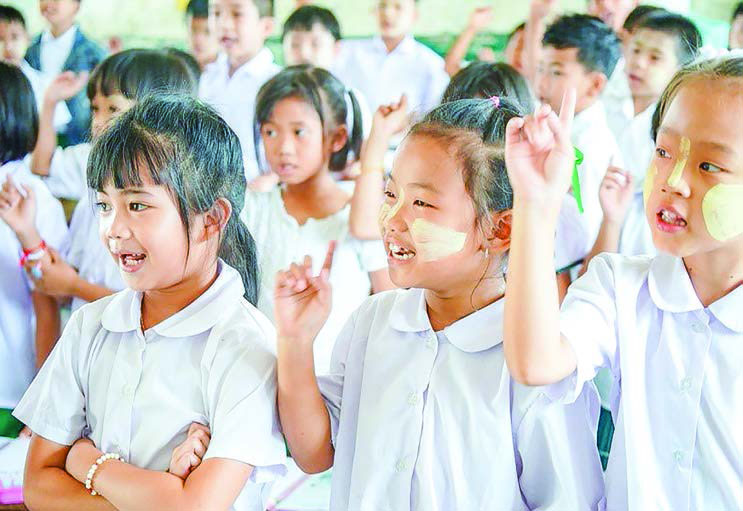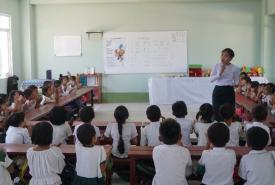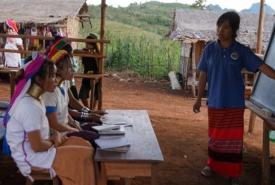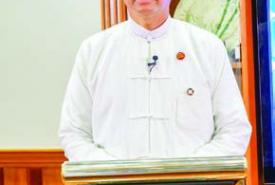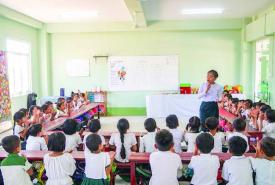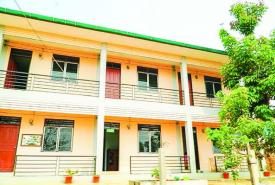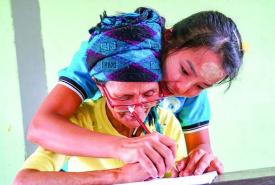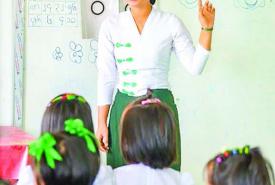6 April
The Ministry of Education and UNESCO collaborated on the Strengthening Pre-Service Teacher Education in Myanmar (STEM) project and will upgrade the 2-year diploma courses in education colleges to 4-year course.
By Nandar Win
Photo: Soe Aung (Education)
Education is an essential resource for national socioeconomic development and something that you have to keep accumulating throughout your whole.
The Ministry of Education strives for education of the highest quality and developed the National Education Strategic Plan (2016-2021) after conducting sound research and producing two inclusive education reports.
The ministry adheres to the following 12 priority tasks promised to the public:
(a) Early childhood care and development.
(b) Ensuring all citizens have primary level education at minimum and creating opportunities for them to access middle and higher level education. Ensuring all school-aged children complete primary school and prioritizing children facing physical, mental, nutritional, economic hardships or those in remote areas to access education.
(c) Adapting school curriculum into ethnic languages for children of ethnic nationals at the primary level through collaboration with state/regional government, and elevating ethnic languages and culture.
(d) Ensuring suitable teacher to student ratio.
(e) Developing the subject expertise and teaching capabilities of teachers of various schools.
(f) Ensuring all citizens have access to basic education and prioritizing schools or underdeveloped regions (especially middle schools and high schools with inadequate school supplies).
(g) Organizing supplementary vocational training for individuals without insufficient educational opportunities.
(h) Supporting colleges and universities to develop their own curriculum and academic autonomy to develop international standard curricula and education systems.
(I) Ensuring technological vocational training develops on the same level as university education.
(m) Ensuring an education system that does not burden student parents or the community.
(n) Ensuring educational budgets provided by the Union Government, the private sector and from sources home and abroad are used in the most efficient manner.
(o) Implementing education reforms, management and research programmes based on accurate information.
The Ministry of Education works hard to ensure there is no discrimination, no one is left behind in education and uniting people for peaceful coexistence, valuing different unique culture through encouraging learning, reading, playing and coexisting together.
The ministry ensures the education system teaches students and all relevant persons accountability and responsibility. Priority task 1 focused on early childhood care and education and 80, 658 preschool children of 3,115 preschools were taught by 4,571 teachers in 2019-2020 academic year.
The ministry also works together with Basic Education Sub Sector Working Group (BESSWG) and affiliations for training preschool teachers for preschool sustainability. There are 873,548 students across Myanmar and opened KG classes with new curriculum in schools across the nation to ensure all children can attend kindergarten.
“We promoted 5,651 schools in the 2019-2020 academic year, especially schools in remote areas of Kayin State, Chin State, Sagaing Region, Magway Region, Rakhine State, Shan State and Ayeyawady Region that had difficulty accessing middle and high school education since 2016,” said Dr Myo Thein Gyi, Union Minister for Education.
The number of middle schools increased by 2,169 and high schools by 2,135 between 2015-2016 to 2019-2020 academic year and the number of teachers for primary, middle and high schools to 7,637, 16,771 and 4,436 respectively. Students for middle and high schools increased to 393,961 and 313,808 and bachelor course students increased to 84,009.
Dr Myo Thein Gyi said the number of students reached 5 million in the seventy years between 1921 to 1988 and has now reached to 9.7 million, meaning there was a 5 million increase in the 30 years between 1988 to now. He said schools still need support with more teachers, classrooms, desks and chairs and libraries for school development.
“The number of Grade 5 graduates increased by 1,695,191 compared to 2015-2016 academic year and Grade 9 graduates increased by 183,289 compared to the same academic year. Over 900,000 applicants took the 2020 matriculation examination, an increase of 333,978 from 2016. There were 267.696 applicants passed the 2019 matriculation exam making it an increase by 70,000,” said Dr Myo Thein Gyi.
The Ministry of Education issued education stipends from 2016-2017 to 2018-2019 academic year and provided K48.065 billion for about 200,000 students. A total of 20,454 schools have been promoted over a 4-year period.
The ministry is testing new DBE boxes in Yangon Region, Mandalay Region and Nay Pyi Taw that contain textbooks, teacher guidebooks, teaching aids, video spots, soft copies of educational documents and augmented reality teaching aids.
Extracurricular primary education was implemented in 95 townships in 2017-2018 academic year for 8135 students, in 90 townships in 2018-2019 academic year for 8946 students and in 85 townships in 2019-2020 academic year for 7545 students.
Extracurricular middle school education was implemented in 8 townships from 2016 to 2018 for 176 students and for a second time in 8 townships in 2019-2020 academic year for 260 students. Fifty-one students who completed extracurricular primary education, transferred to school education systems and passed the matriculation exam.
Soft copies of textbooks for grades 1, 2, 3 and 6 are uploaded on nepc.edu.mm and derpr.moe.edu.mm. Soft copies for grades 4, 7 and 10 are slated to be uploaded in 2020-2021 academic year.
The Ministry of Education has collaborated with state/regional governments to provide education for grades 1 to 3 in 63 ethnic languages. There are 11298 teaching assistants and 14786 language teachers teaching over 800,000 students in 13100 schools across the nation.
The ministry collaborated with the Ministry of Ethnic Affairs, state/regional governments and ethnic literature and culture committees and UNICEF to research the effectiveness of ethnic language teaching in 7 states. They were able to develop vocabulary cards in English-Myanmar-ethnic languages for Jing Phaw, Kayah, Sagaw Kayin, Chin (Falam), Mon, Rakhine and Shan languages and in Jing Phaw, Lawwai, Kayah, Poe Kayin, Chin (Haka), Chin (Falam), Mon and Shan languages for Grade 1, Grade 2 and Grade 3.
Primary and middle school teachers were given training on the new textbooks and teaching guidebooks for Grade 3 and Grade 6 in 2019-2020 academic year. Similar training for teachers of grades 4, 7 and 10 are planned for 2020-2021 academic year.
“In the technical and vocational skills sector, 137 teachers were given training in Belin in 2019-2020 FY,” said Dr Myo Thein Gyi. “Training for the 4-year curriculum at the Education Degree College for the teachers was given in October and November 2019. We partnered with the British Council, VSO, the Open University and Montrose Consulting in implementing the Towards Results in Education and English (TREE) project for teachers of 25 education universities,” he added.
Between 2016-2017 academic year and 2018-2019 academic year, 368 professionals from abroad were teaching in colleges and universities across Myanmar. There were 138 active MoUs and MoAs with international universities and organizations between the same academic years.
The Ministry of Education and UNESCO collaborated on the Strengthening Pre-Service Teacher Education in Myanmar (STEM) project and will upgraade the 2-year diploma courses in education colleges to 4-year course. International Quality Assurance Units have been set up in colleges and universities across the nation as well.
In point 6 of the ministry’s 12 priority tasks, a total of 14473 school buildings were built between 2016-2017 and 2018-2019 academic years to allow more access to education in underdeveloped regions, spending K520.520 billion for that purpose.
Dr Myo Thein Gyi said the joint Povery Report with the World Bank and Ministry of Planning, Finance and Industry found higher cases of poverty in Ayeyawady Region, Shan State, Sagaing Region, Magway Region and Rakhine State. He said those with the highest poverty rates had never even been to school. Those who dropped out after primary or high school could only get low-income jobs and the only way for them to get better paying jobs is to complete high school education and acquire vocational, scientific and college education, said the Union Minister.
Another joint report with World Bank and MoPFI in 2020, the Social Economic Report, showed the highest dropout rates were in Shan State, Rakhine State, Kayin State, Mon State, Ayeyawady Region, Bago Region, Taninthayi Region and Yangon Region.
The Union Minister said there have been development as people between 15 to 24 have a 50.24 per cent attendance rate for middle, high and vocational training schools and colleges, 59 per cent attendance in high schools and 78 per cent attendance in middle schools.
Distance education is another important sector that has been given priority and the Transformation by Innovation in Distance Education (TIDE) opened the third Residential School courses with 200 teachers from 20 universities across the nation receiving training.
The ministry utilized K171.692 billion for school development between 2016-2017 and 2018-2019 academic years, K13.574 billion to distribute exercise books for free, and K146.056 billion to distribute school textbooks for free as well.
Then in 2019-2020 academic year, the ministry utilized K59.378 billion to develop schools, K9.571 billion to distribute exercise books and K 108.233 billion to distribute school textbooks for free.
The Ministry of Education finds that rote memorization is the biggest obstacle to developing critical thinking and problem solving skills, innovation and social skills. The ministry will continue to implement the National Education Strategic Plan with transparency and efficiency in order to elevate the entirety of the educational sector in Myanmar.
(Translated by Zaw Htet Oo)
